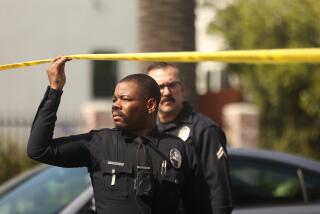Crime Drops in Valley Despite Recent Violence
- Share via
Despite a recent wave of high-profile carjackings and ATM robberies, overall crime in the San Fernando Valley has decreased across-the-board in the first three months of this year, according to Los Angeles police statistics.
A possible explanation: Heavy rains kept criminals indoors.
Murders, robberies, rapes, assaults, burglaries and auto thefts have all dropped in the first three months of this year in the Valley compared to the same quarter last year, the department reported. These statistics reflect comparable citywide decreases in the same categories except for homicides, which increased citywide but dropped in the Valley.
Deputy Chief Mark A. Kroeker, commander of Valley operations, attributed the lower crime rate to the Valley’s program of community-based policing, which stresses crime prevention and citizen involvement.
But he also conceded that some of the drop may have occurred because there was more rain in the first three months of this year than any year since 1984. Criminals, especially in Southern California, avoid the streets in bad weather.
“There’s been a lot of rain--and that makes a difference, but I can’t help but to think that it has gone down because of community-based policing,” said Kroeker, who points out that during the three-month reporting period, crime was down even on sunny days and clear nights.
Under the Valley’s program for community-based policing, senior patrol officers who formerly spent most of their time responding to calls for service now spend 40 hours a week on community relations. Since assigning those officers to community organizing in 1991, the Valley divisions have established a vast network of several hundred citizen volunteers who report suspicious activity near their homes to police. The long-term goal is to establish a Neighborhood Watch group on every residential block in the Valley.
But the fear among police has been that response times--the amount of time that it takes for a patrol car to get to an emergency crime scene--would increase to an unacceptable level if too many officers were occupied with community relations.
But response times for the first three months of this year were about 8 minutes--virtually unchanged from the same period last year, according to Kroeker’s office.
Despite the drop in crime, many citizens still live in fear, if not for themselves, then for a colleague, friend or relative.
“Even if the numbers are not higher, people are really afraid that they’re going to be the next victim,” said Detective Al Michelena, who tabulates crime statistics for the Valley.
Neighborhood groups applauded the statistical drop in crime, but members reported no change in their day-to-day lives.
“Statistics are not what make people safe or unsafe,” said Richard H. Close, president of the Sherman Oaks Homeowners Assn. “They need to feel they can walk safely down the street in their neighborhood or in their local mall.”
Close, a 19-year resident of the Valley, said, “In the 1970s and ‘80s you were not safe only if you went to the wrong part of the Valley, but now, no place in the Valley is safe.
“When a pregnant woman gets killed in Sherman Oaks trying to take money from an ATM, how can anyone feel safe?” Close said, referring to the death of Sherri Foreman, a pregnant woman who was fatally stabbed during a carjacking outside a bank on March 30.
Kroeker conceded that police need to make citizens feel safer as well as be safer. To better understand the mood of Valley residents, Kroeker’s office is going to mail out surveys on police service this week to a thousand Valley homes.
In the Valley, there were 31 homicides through the end of March this year, compared to 33 in the same quarter last year and 38 in 1991. The Valley decrease compares with the increase for the rest of Los Angeles, where there were 211 homicides in the first quarter, compared with 190 last year.
Rape also decreased, to 105 from 109 last year and 108 in 1991.
After a sharp increase in 1992, robbery dropped to 1,788, from 1,928 last year and 1,452 in 1991.
Aggravated assaults decreased to 2,434, nearly their 1991 level of 2,357 after an increase last year to 2,546.
Burglaries fell to 4,238, compared to 4,567 last year and 4,441 in 1991.
Auto theft dropped to 5,642, compared to 6,077 last year and 5,305 in 1991.
The statistical picture is murky on two crimes that have gripped the public imagination recently: carjackings and ATM robberies.
Los Angeles police do not tabulate these two crimes separately from other robberies and auto thefts. But in part because of pressure from the public and news media, some detectives have been keeping their own numbers on carjackings and ATM robberies.
In the West Valley Division, Detective Robert Johansen said there have been seven ATM robberies and six carjackings so far this year.
“We’d like to compare what’s going on here to the whole city,” Johansen said. “But the way it’s set up we would have to go through every report.”
More to Read
Sign up for Essential California
The most important California stories and recommendations in your inbox every morning.
You may occasionally receive promotional content from the Los Angeles Times.













